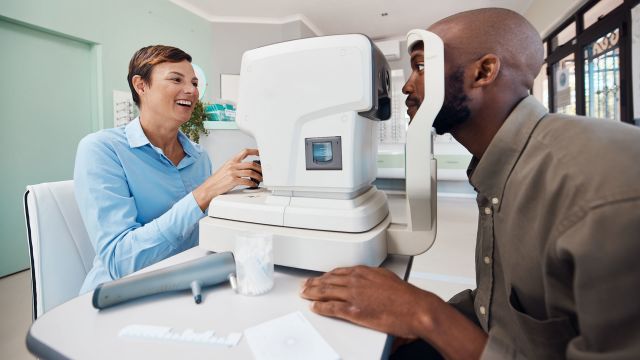Updated on March 21, 2024.
Diabetic retinopathy is one of several diabetes complications that can affect the eyes. It occurs when high blood sugar levels damage the delicate blood vessels in the retina, the layer of light-sensitive cells called photoreceptors cells in the back of the eye.
The retina plays an important role in vision, and when it becomes damaged, a person’s vision can become impaired. Diabetic retinopathy is the leading cause of vision loss among people who have diabetes.
What is the first sign of diabetic retinopathy?
Usually, the first signs of diabetic retinopathy are microaneurysms. Aneurysms occur when blood vessel walls become weakened. Blood pushes into the weakened points, forming bulges or balloons that push outward.
When a person has diabetic retinopathy, aneurysms form on the tiny blood vessels in the retina. These are called microaneurysms or retinal microaneurysms.
Diabetic retinopathy may not cause any symptoms or any noticeable symptoms in the early stages. Even without symptoms, microaneurysms can be detected by an eye doctor examining the back part of the eye, where the retina is located.
How is diabetic retinopathy diagnosed?
The exam that an eye doctor will use to examine the back of the eye is called an ophthalmoscopy. There are several different techniques for performing an ophthalmoscopy, but they all follow the same basic idea—using bright lights and magnifying lenses to view the inner parts of the eyeball.
During this exam, microaneurysms appear as tiny red dots. These dots may be surrounded by yellowish rings. These rings are deposits of waxy residue left behind when blood and fluid leak out of microaneurysms and into the eye. These deposits are called hard exudates.
Other signs of diabetic retinopathy include dot and blot hemorrhages and cotton wool spots. Dot and blot hemorrhages are microaneurysms that have ruptured and started to leak. Cotton wool spots are a type of lesion that look like flecks of white paint. These are a sign that diabetic retinopathy is worsening.
In the advanced stage of diabetic retinopathy, new blood vessels begin to grow in and around the retina. This is the body’s attempt to supply this part of the eye with blood when the existing blood vessels have stopped working. This stage is called proliferative diabetic retinopathy. These new blood vessels do not function normally, will leak blood and fluid into the eye, and have a higher risk for other complications, including macular edema (swelling of a part of the retina called the macula, which allows you to see objects in front of you) and retinal detachment (separation of the retina from the back of the eye).
How to prevent diabetic retinopathy
If you have diabetes, you are at risk for diabetic retinopathy. And the longer you have had diabetes, the greater your risk.
Keeping diabetes well controlled is the best way to prevent diabetic retinopathy as well as other complications. Keeping diabetes well controlled is also essential to treatment at any stage of diabetic retinopathy.
If you have diabetes, it’s very important to keep up with your regular eye exams. Like many complications of diabetes, treatment works best when it is started as early as possible. In the early stages, treatment will likely focus on better diabetes control and more frequent eye exams, where your eye doctor will check for signs that diabetic retinopathy is getting worse—so they can adjust treatment accordingly.
In the more advanced stages, treatment may include laser surgery, injections of anti-VEGF medications (which block formation of abnormal or leaky blood vessels), or other surgical procedures that can seal off leaking blood vessels, slow and prevent the formation of new blood vessels, and repair damage to the retina. If you have questions about diabetic retinopathy and whether your insurance covers treatment for it, ask your healthcare provider.






